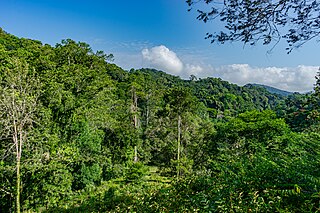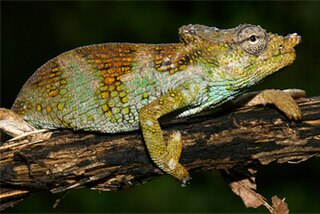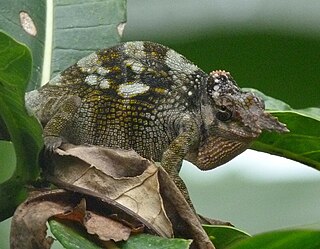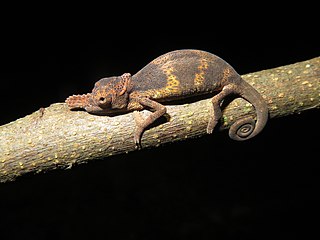
Fischer's chameleon, also known commonly as the Nguru blade-horned chameleon and the Nguru two-horned chameleon, is a species of chameleon, a lizard in the family Chamaeleonidae. The species is endemic to Tanzania.

The strange-horned chameleon, also known as Rwenzori plate-nosed chameleon or single welded-horn chameleon, is a species of chameleon. It is native to the rainforests of the Ruwenzori Mountains of western Uganda and eastern Democratic Republic of the Congo.

The Amani Forest Reserve, officially listed as Amani Nature Forest Reserve is a protected area located the Muheza and Korogwe Districts in the Tanga Region of Tanzania. The nature reserve was established in 1997 in order to preserve the unique flora and fauna of the East Usambara Mountains. The East and West Usambara Mountains are a biodiversity hotspot. The Amani Nature Reserve includes tropical cloud forest habitats.

The Sokoke scops owl is a highly localized species of scops owl found in lowland forests of Kenya and Tanzania. The greatest population of this species of owl is in the Cynometra-Manilkara forest, which is less than one-third of the Sokoke Forest. It is also found in the Afzelia-Cynometra forest.

The Mazumbai warty frog is a species of frogs in the family Brevicipitidae. It is endemic to forests of the West Usambara Mountains of Tanzania where it is threatened by habitat loss. It is part of a species complex and was recognised as a separate species in 2004, having previously been included in Callulina kreffti.

Fischer's turaco is a species of bird in the family Musophagidae. It is found in Coastal East Africa, including Kenya, Somalia, and Tanzania. Its natural habitats are subtropical or tropical moist lowland forest, subtropical or tropical moist montane forest, and arable land. It is threatened by habitat loss and trapping for the wildlife trade.

Kinyongia vanheygeni, the Poroto single-horned chameleon or Van Heygen's chameleon, is a species of chameleon, a lizard in the family Chamaeleonidae.

Kinyongia tavetana, the Kilimanjaro two-horned chameleon or Kilimanjaro blade-horned chameleon, is a species of chameleon in the genus Kinyongia. It is native to forests, woodlands, well-wooded gardens and plantations in the highlands of southern Kenya and northern Tanzania. Its type locality is Mount Kilimanjaro, but it is also known from Chyulu Hills and Mount Meru to the Pare Mountains.

The sharp-nosed chameleon is a chameleon native to the Uluguru and Udzungwa Mountains of Tanzania, where it inhabits forests, woodlands and plantations at an altitude of 1,400–1,900 m (4,600–6,200 ft) above sea level.
The spiny-flanked chameleon, also known as the spiny-sided chameleon, is a species of chameleon endemic to Tanzania. It was first described in 1932 by Arthur Loveridge.

Trioceros deremensis, the Usambara three-horned chameleon or wavy chameleon, is a species of chameleon native to Tanzania.

Kinyongia tenuis, also known as the Usambara soft-horned chameleon, Usambara flap-nosed chameleon and Matschie's dwarf chameleon, is a fairly small species of chameleon from Kenya and Tanzania.

Kinyongia matschiei, common name giant monkey-tailed east Usambara two-horned chameleon, giant east Usambara blade-horned chameleon, and Matschie's two-horned chameleon, is a species of chameleon from the East Usambara Mountains in Tanzania. It was formerly confused with K. fischeri, which is not found in the range of K. matschiei.

Kinyongia boehmei, the Taita blade-horned chameleon, Böhme's two-horned chameleon and Dwarf fischer's chameleon, is species of chameleon, a lizard in the family Chamaeleonidae, found only in the Taita Hills of southeastern Kenya. It is the smallest species in the East African "two-horned chameleon" group and until 2008 it was generally considered a part of K. tavetana.
Kinyongia gyrolepis is a species of kinyongia chameleons first described in 2012, and the sister species to the Kinyongia adolfifridericichameleon. It is more commonly known as the circular-scaled chameleon.

Kinyongia uluguruensis is a species of chameleon, also known as the Uluguru two-horned chameleon or Uluguru two-horned chamaeleon. It is endemic to highland forests in the Uluguru Mountains of Tanzania.

Kinyongia uthmoelleri, known commonly as the Hanang hornless chameleon, Müller's leaf chameleon, and Uthmöller's chameleon, is species of lizard in the family Chamaeleonidae. The species is endemic to Tanzania.

Kinyongia vosseleri, also known commonly as the Usambara two-horned chameleon and Vosseler's blade-horned chameleon, is an endangered species of lizard in the family Chamaeleonidae. The species is endemic to Tanzania.

Trioceros werneri, the Wemer's chameleon or Wemer's three-horned chameleon, is a species of chameleon that is endemic to forests and nearby gardens in the Eastern Arc Mountains of Tanzania. The adult male as three distinct "horns", whereas the female has no or only a single short horn on the nose. Although currently recognized as a single relatively widespread species, it is considered likely that it is a species complex and a taxonomic review is necessary.




















